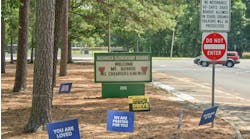Crises and catastrophes can strike without warning. Impulsive acts of violence or natural disasters can easily set off a wave of panic. It’s especially true on a school or university campus, where thousands of students are likely to be looking to administrators for guidance on where to go and what to do.
For years, school security advocates have warned educators and administrators: Every school needs to create an emergency preparedness plan; staff members must be thoroughly informed about its contents and trained regularly about their responsibilities in a crisis; and the plan should be continually updated as events and conditions warrant.
In “Practical Information on Crisis Planning: A Guide for Schools and Communities,” the U.S. Department Of Education’s Office of Safe and Drug-Free Schools sums up the vital need for schools to have an updated emergency management plan in place.
“Teachers and staff must know how to help their students through a crisis and return them home safely,” the guide says. “Knowing what to do when faced with a crisis can be the difference between calm and chaos, between courage and fear, between life and death.”
For the most part, schools and universities have received the message. The Government Accountability Office (GAO) estimates that 95 percent of all districts have written emergency management plans. But the Virginia Tech massacre demonstrates the difference between having a plan and having the right plan. Communities across the nation look at the safety on the nearby campuses and ask: How would we have responded? Are there flaws in our crisis plans? How can we improve our emergency preparedness?
Each education institution has to answer those questions for itself. Government agencies and school security experts can provide direction, but an emergency management plan has to reflect the specific conditions and culture of an individual campus.
“Each community has its own history, culture and way of doing business,” says the U.S. Education Department’s crisis-planning guide. “Schools and districts are at risk for different types of crises and have their own definitions of what constitutes a crisis. Crisis plans need to be customized to communities, districts and schools to meet the unique needs of local residents and students. Crisis plans also need to address state and local school safety laws.”
The basics
Security experts have broken down the elements of an emergency management plan into four categories. In its guide, the U.S. Education Department defines them:
• Mitigation and prevention: What schools and districts can do to reduce or eliminate risk to life and property.
• Preparedness: The process of planning for the worst-case scenario.
• Response: The steps to take during a crisis.
• Recovery: How to restore the learning and teaching environment after a crisis.
To create an effective plan, the guide recommends that the top leadership at a school or university make crisis planning a priority. School officials should cultivate relationships with city emergency managers, public works officials, health professionals and the news media before a crisis occurs. Educators should develop crisis plans in partnership with local law enforcement, fire safety, emergency services and health professionals. Crisis plans should give special attention to students or staff with special physical needs or developmental issues, as well as students with limited proficiency in English. Schools should also give students and staff training and have them practice what to do in an emergency so they can react properly if an incident occurs.
How schools are doing
After many highly publicized crises at schools and universities in recent years, education administrators should be well aware of how important and necessary an emergency preparedness plan is. But after the publicity from a school tragedy subsides, many institutions may not be as attentive to their crisis plans as they should.
To assess whether school districts have effective emergency management plans, Congress directed the GAO to look at the adequacy of those plans and whether federal agencies can offer any assistance to improve those plans.
The report, issued last month, concluded that emergency management plans in many school districts could benefit from additional federal guidance. The GAO report found that most districts have developed emergency management plans, but many of the plans do not include some practices recommended by federal agencies.
The GAO says that 32 states have laws or other policies requiring school districts to have emergency management plans; 47 states say they provide guidance to school districts on emergency management plans; and 37 states say they offer training to districts. But even with that assistance, some schools say they don’t have the resources needed to fully develop a plan.
“In many school districts, officials struggle to balance priorities related to educating students and other administrative responsibilities with activities for emergency management,” the GAO says.
Lack of equipment, inadequate training and a lack of personnel with expertise in emergency planning are obstacles in an estimated 62 percent of school systems.
“The lack of equipment prevents districts from implementing the procedures in their plans and hinders communications among district staff and with first responders during emergencies,” the report says.
In some districts, administrators were reluctant to use teacher development training time for emergency management because of other training priorities.
Other GAO findings:
• Because the Department of Homeland Security’s (DHS) guidelines for certain funding initiatives do not clearly state that school districts are eligible for money, some states may be uncertain whether they can allocate those funds to school systems. “School districts in these states may not have the opportunity to benefit from this funding,” the GAO says.
• More than half of districts with emergency management plans do have procedures for continuing student education in the event of an extended school closure, “such as one that might occur during a pandemic.”
• Fewer than half of school districts have involved the local head of government or the local public health agency in developing their emergency management plans.
• About half of all school districts update their emergency management plans once a year, but about 10 percent have never updated their plans.
• About 73 percent of school districts regularly conduct some type of school drill or exercise to prepare for emergencies such as evacuations, lockdowns and shelter-in-place.
• About 65 percent of districts say they have a storage location and replenish emergency supplies such as food, water and first-aid supplies.
• Most districts practice their plans annually within the school community, but more than a quarter of districts have never trained with first responders; more than two-thirds do not train regularly with community partners on how to carry out emergency management plans.
• A significantly higher percentage of urban schools (69 percent) update their emergency preparedness plans annually, compared with rural schools (43 percent).
• A greater number of urban districts (78 percent) coordinate their plans with local government response plans, compared with rural districts (45 percent).
To help school districts bolster their emergency management plans, the GAO urges federal agencies to take several steps:
• The DHS should make it clear to state and local governments that school districts and universities can receive funds through the State Homeland Security Program, the Urban Areas Security Initiative and the Citizen Corps grant program.
• The Departments of Education and Health and Human Services (HHS) should collaborate to identify successful strategies and help schools spell out in their emergency plans how they will continue educating students if schools have to be closed for an extended time.
• Education and HHS should work together to identify ways to shelter and remove special-needs students from school facilities in an emergency.
• The Education and Homeland Security departments should try to identify what factors are preventing school districts, first responders and community partners from training together, and develop strategies for making those partnerships more common.
Sidebar:
Staying Vigilant
Some state and local agencies have recognized how critical it is for school districts to have an effective and up-to-date emergency preparedness plan. Like the GAO report, they have found flaws that need to be addressed.
In Orange County, Calif., a grand jury looking into emergency preparedness at school districts concluded that few schools had well-developed plans for responding to a major crisis.
“The results of our study indicate that, with the exception of a few schools, most plans were in need of much improvement,” the grand jury said. “Some plans were very skeletal, covering earthquake duck-and-cover and fires only. Some districts appear to have been unprepared for the materials we asked them to provide.”
In Pennsylvania, Auditor General Jack Wagner conducted a survey of the state’s school districts and found that although most had school safety plans, most of the plans were lacking in critical elements. Based on a preliminary review, 42 percent of local education agencies in the state “do not have plans with a school visitation policy and a policy for student, staff and visitor identification.” The data also indicated that 56 percent of local education agencies and 36 percent of charter schools do not have plans that call for single entry points for students, staff and visitors at all buildings.
“We in state government must make sure that school safety plans are manageable working documents that are routinely tested and evaluated,” Wagner says.

